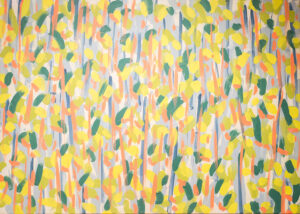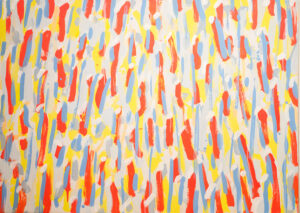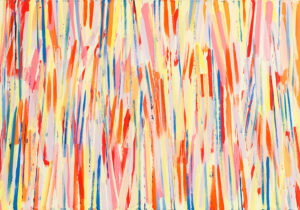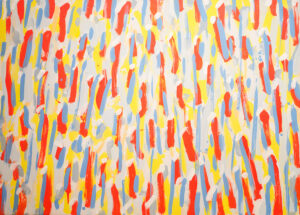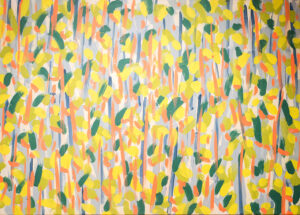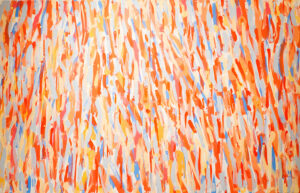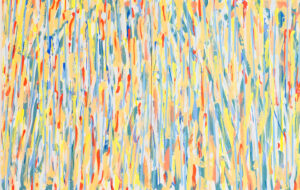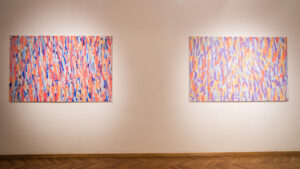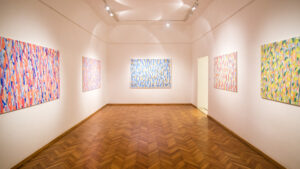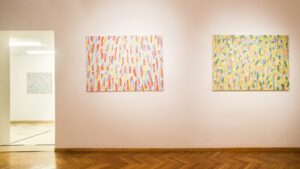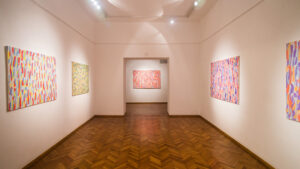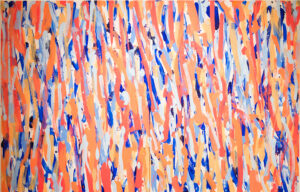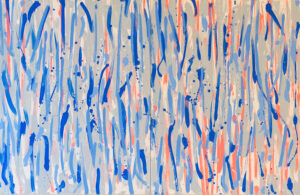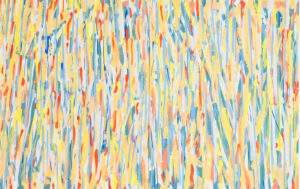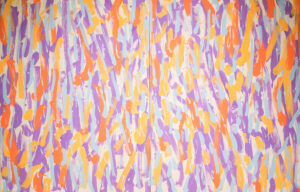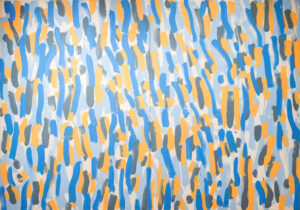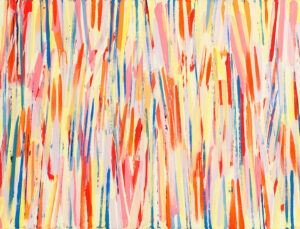Struktura koja buja
Umjetnik Vanja Pagar fini je manipulator morfologijom likovnog govora i alkemičar sintakse jezičnih struktura. Umjetnik je to koji na sve ima konstruktivne i zdrave odgovore, nadasve pun angažmana i zanimanja za nove, recimo tako (mi što nam je vrijeme stalo), medije. Naoko, sve su to neki, barem što se slikarstva tiče, fini, gotovo neprimjetni pomaci kroz tematske zanimacije, vidljivi tek u prezenterskom prerasporedu. Ticat ćemo se i tek telegrafski tražiti niti poveznice za igrariju simpatično i logično naslovljenu Šarene slike. Ne, nisu te slike pale s Marsa, tek tako kao domišljatost inventivna i nemirna kreativca. Imaju one neku svoju genezu, razvojne planove i teoretske postavke.
U srži svega kao da je genetski modificirani koloristički bipol Maljeviča, slavljen na prvim izložbama koji se vremenom umnažao. Par održivih odnosa boja iz pravokutnika zadatosti u međuvremenu se kotio i razmnožio da traži pokriće u stvarnoj slici, u prizorima iz života. No, valja apostrofirati kako ipak ništa nije slučajno, barem što se tiče postaja na trasi od dva obojena kvadratića do Šarenih slika. Kombinirali smo s Pagarom u igraonici za odrasle preslagujući male slike u veliku cjelinu. „Skidali s polica knjige“, jasno islikane, i tražili iste elemente potom u jedrilju i njegovim regatama, poštujući nadasve geometrijsku harmoniju kao prapočelo svega… Na koncu je ipak proradio slikar i zanemario ravnalo, odnosno letvicu kao pomagalo, pustio ruci da zapleše. Istina i ples imaju svoja pravila, koreografiju, linijski raspored kretanja, jer reda mora biti pa makar to bilo i u savršenom neredu. I opet čvrste linije povremeno naprave kordon da se masa ne rasprši, ne otme kontroli… Volim slike Pagarove i zbog notorne istine da mi ostavljaju slobodu raspredati o stanjima i raspoloženjima. To nije sračunato poskakivanje po valerima, koliko svjedočenje o stanju duha i raspoloženja, pa i austenitnoj korelaciji s gledateljem.
Možda će vam poput mene pasti na pamet Vivaldijeva Četiri godišnja doba, možda ćete ishitreno prepoznati splitsku Pjacu turistički raspojasanu i punu dobrodošlice. Moguće će ovi, poput mene, što gataju u svemu i svačemu, snimiti mikrostrukturu i prepoznati martenzitno gradbeno tkivo, igličaste kristale koji se tangiraju pod određenim kutovima. Imajte na umu, martenzitnu strukturu karakterizira najveći mogući volumen od svih čeličnih struktura. Ovo su slike koje bujaju! Metalurzi bi upozorili, u isto vrijeme to su tvrde, a opet krhke strukture. Djelo i slikara tu vidim u neraskidivoj vezi! Raspoloženje umjetnika mjeri se Brinellima, a sve je posljedica termičke obrade, gdje je temperatura jedina varijabla.
Vrijeme je tu zanemarivo i nebitno.
Igor Brešan, 2016
Blooming Structure
Artist Vanja Pagar subtly manipulates visual language morphology and may be considered an alchemist of language structures’ syntax. He is an artist that provides constructive and valid answers to every question, fully engaged and interested in new, as we (for whom the time has stopped) like to say, media. At a first glance, in terms of painting at least, it is mostly about delicate, almost unnoticeable movements through thematic pursuits, visible only in presentational rearrangement. We will briefly mention and only telegraphically look for relations within this frolic, aptly and logically named Colourful Paintings. No, these paintings did not fall from Mars, and neither did this innovative and restless individual’s creativity. They have their own genesis, plan of development and theoretical foundations.
In the centre of it all, there is something reminiscent of a modified colouristic Malevich’s bipole, celebrated in first exhibitions and multiplied with the passing of time. In the meantime, couple of sustainable colour relations grew in numbers to seek refuge in real image, in scenes from real life. However, nothing is coincidental, at least in the case of the stations placed on the route beginning with two coloured squares, all the way to Colourful Paintings. In an adult playroom, we and Pagar attempted to reorganise smaller paintings into a greater composition. “We took books from the shelves” and searched for the identical elements in sails and regattas, paying respect to geometrical harmony, a source of everything. In the end, the painter did his own thing, dismissing technical aid of a ruler and letting his hand dance. Truth and dance have their own rules, such as choreography and linear movement, because there has to be order, even if we are talking about a perfect disorder. And again, thick lines occasionally create a cordon for the mass so it does not disperse and remains under control. One of the reasons I like Pagar’s paintings is because of the notorious truth that allows the freedom to talk about different states and moods. It is not so much about calculated skipping on colour valeurs, as it is about the testimony of the state of spirit and mood, as well as the austenite correlation with the spectator.
Maybe, like me, you will think of Vivaldi’s Four Seasons, or recognise Split’s Pjaca, flamboyant, welcoming and crowded with tourists. It is possible that people such as I, who talk about all and everything, will take note of the microstructure and recognize martensite thread, needle crystals that touch under specific angles. Bear in mind, martensite structure is characterised by possessing the greatest volume of all steel structures. These are blooming paintings! Still, metallurgists would probably warn about the fact that, at the same time, they are solid, yet still fragile structures. Here I see the inseparable relation between the painter and his work. Artist’s mood is measured in Brinell scale, and everything is a consequence of thermic processing, where the only variable is temperature.
Time is peripheral and irrelevant.
Igor Brešan, 2016
Čista radost slikanja
Najnovija izložba u galeriji Matice hrvatske, ona splitskog umjetnika Vanje Pagara, iznenađuje ponajprije zato što je riječ o slikarskom ciklusu. Premda je Pagar po vokaciji akademski slikar, posljednjih je desetak godina radio sve osim slikarstva. Iz početnih slikarskih radova i promišljanja esencije slikarskog jezika uopće, karakterističnih za njegov rani rad, Pagar je krenuo prema instalaciji, akcijama i performansu. Taj dio njegova opusa, da se tako izrazimo, karakterizira jak društveni angažman i izražena kritika ideoloških i socijalnih paradigmi našeg vremena. Tako je u Rijeci 2004. priredio akciju nazvanu Anđelko ili ručak u parku, u kojoj je u ulogu performera stavio lokalnog beskućnika koji je imao zadatak provesti publiku gradom, ali svojim uobičajenim rutama, te ih je istovremeno upoznavao s načinom preživljavanja na ulici. Dati publici drukčiju perspektivu, svjedočanstvo o životu s margine društvenog, životu koji odbacuje vladajuće paradigme, bila je ideja tog performansa/akcije.
Ovaj najnoviji ciklus, osim što naznačuje Pagarov (barem privremeni) povratak slikarstvu, neobičan je i zbog svoje posvemašnje neangažiranosti. Radovi predstavljeni na ovoj izložbi najjednostavnije bi se mogli okarakterizirati kao čista radost slikanja, što podupire i nepretenciozan naslov ciklusa – Šarene slike. Privremena je to pobjeda estetike nad etikom u kontekstu vječne rasprave o smjerovima i ciljevima suvremene umjetnosti.
Ono što vidimo i jesu upravo šarene slike. Koloristički razigrane kompozicije utemeljene na igri dvaju elemenata – poteza i boje. Neki od radova djeluju snažno nadahnuti apstraktnim ekspresionizmom, dok se u drugima slikar poziva na neku vrstu reda okomica i dijagonala, što stvara dojam iznenadne ozbiljnosti i strogoće unutar inače posve zanesena, dječje zaigrana eksperimenta.
Eksperiment je ujedno i riječ koja mi prva pada na pamet kad razmišljam o Pagarovoj izložbi. Kao da je u tim slikama svjesno napustio sve znanje (ali ne i vještinu) i teret naobrazbe te se prepustio golom instinktu i tako realizirao priču o stanjima i raspoloženjima izraženim kroz vividni kolorit i brze, nemirne poteze kistom. Pagar izvrsno barata bojom, tonom i odnosima boja nerijetko posežući za komplementarnim parovima žute/ljubičaste i plave/narančaste, samo da bi ih onda „utopio“ ili, bolje bi bilo reći, uklopio u nove kolorističke odnose. Ekspresija je naglašena upravo tom eksplozijom boja na njegovim slikama, ali i bitno utemeljena u već spomenutom karakterističnom potezu. Pagarovi potezi kistom jedni drugima protuslove i međusobno se poništavaju, ali slojevi boja naizgled nemarno naneseni jedni povrh drugih ističu neku vrstu kaotičnog sklada i čine te slike u svakom pogledu uspjelima. Umjetnik mijenja smjer kretanja kista, ostavlja vidljivom bjelinu platna, dopušta boji da kapa, mjestimično rasprkava boju po platnu… On šara svoje šarene slike i čini to izrazito vješto. Upisuje nove boje i oblike na one već nanesene na platno te se čini kao da te slike ni sad još nisu gotove. Ne u smislu da ostavljaju dojam nedovršenosti, već kao da bi se na već završenim platnima mogle započeti nove, začudne kompozicije.
Dojam koji Pagarov ciklus na mene ostavlja jest kao da gledam u seriju nadrealistički očuđenih livada s cvijećem ili u esenciju ljeta i sunca. Umjetnik svoja raspoloženja bilježi vedro i sugestivno, a publici ostavlja širok spektar mogućih interpretacija ne ograničavajući moguća tumačenja čak ni naslovima slika. On, naime, slikama dodjeljuje tek brojeve te i tu izostaje strogoća okvira unutar koji bi valjalo doživljavati odnosno interpretirati izložene radove. Tako se autorova sloboda kreacije širi i na slobodu interpretacije od strane publike, iz čega bi se dala iščitati latentna poruka da je jedna od bitnih karakteristika umjetnosti upravo sloboda, odnosno načelna neopterećenost dogmom. Te slike sadržavaju nešto primarno, nepretenciozno i autentično. One su djelo odraslog čovjeka koji je uspio pobjeći težini iskustva i načas postojati isključivo unutar igre.
Ana Čveljo, 2017
The pure joy of painting
Vanja Pagar’s latest exhibition at Matica hrvatska Gallery is surprising primarily because it is a series of paintings. Despite Pagar’s vocation as an academic painter, he has been pursuing everything but painting for the last ten years. From his initial works and reflecting on the essence of artistic language in general, characteristic of his earlier phase, Pagar moved towards installation, actions and performance. This part of his opus, so to speak, is characterized by strong social engagement and expressed criticism of ideological and social paradigms of our time.
To illustrate, in 2004 he organised an action in Rijeka, called Anđelko or lunch in the park, where he chose a local homeless person as a performer, whose task was to lead the audience through the town, along his usual routes, simultaneously familiarising them with his way of surviving the streets. The idea of this performance/action was to provide the audience with a different perspective, a testimony of life on the margins of society, a life that rejects the ruling paradigms.
His latest series of paintings, besides indicating Pagar’s (at least temporary) return to painting, is unusual for its complete lack of social engagement. The works presented at this exhibition could simply be characterised as pure joy of painting, supported even by their non-pretentious title – Colourful paintings. It is a temporary victory of aesthetics over ethics in the context of the eternal debate on the directions and goals of contemporary art.
The colourful paintings are exactly what we see. Coloristic playful compositions based on the play between two elements – stroke and colour. Some of the works appear strongly inspired by abstract expressionism, while in others the author relies on a certain set of verticals and diagonals, giving the impression of sudden seriousness and strictness within predominantly enthusiastic, childlike playful experiment.
Experiment is also the word that first comes to my mind when I think about Pagar’s exhibition. As if he consciously abandoned of all his knowledge (but not the skill) and the burden of education with these paintings, surrendering himself to the bare instinct, thus carrying out the story of the states and moods expressed through the vivid colouring and swift, restless brush strokes. Pagar is a master of colour, tone and colour combinations, frequently choosing complementary pairs of yellow/purple and blue/orange, only to “drown” them, or more precisely, to blend them in new coloristic relations. The expression is emphasized by this very colour explosion on his paintings, but is also significantly based on his already mentioned characteristic stroke.
Pagar’s brush strokes are contradictory and counteract each other but the paint layers, seemingly recklessly applied one over the other, indicate a certain chaotic harmony and make these paintings a complete success. The artist changes direction of brush strokes, leaves the whiteness of the canvas visible, lets the colour drip, sporadically spraying the paint over the canvas… He doodles his colourful paintings and is quite skilful at it. He inscribes new colours and shapes over the ones already applied on the canvas, making the paintings seem still unfinished. Not in a sense that they give the impression of incompleteness, but as if one could use the finished canvases to create new wondrous compositions.
The impression that Pagar’s series gives me is that of a series of surrealistic wondrous meadows with flowers or the essence of the summer and the sun. The artist records his moods in a bright and suggestive manner, providing the audience with a wide spectrum of possible interpretations, not limiting them even by the paintings’ titles. Namely, he assigns only numbers to his paintings, again avoiding the rigidity of the frame within which the exhibited works should be experienced or interpreted.
The author’s creative freedom thus spreads to interpretative freedom by the audience, suggesting the latent message – one of the essential characteristics of art is the freedom itself, namely the basic freedom from dogma. These paintings comprise something primary, non-pretentious and authentic. They are the work of a grown man who managed to escape the burden of experience and to exist only within play for a moment.
Ana Čveljo, 2017
